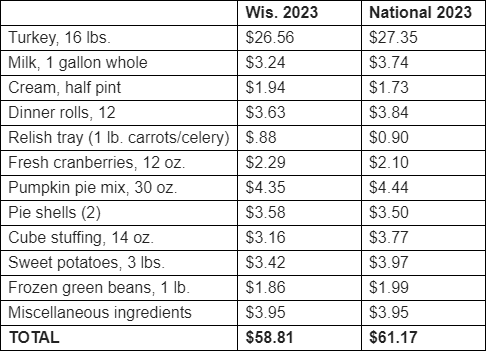The price of a traditional Thanksgiving meal in Wisconsin is 1.36% less this year according to Wisconsin Farm Bureau’s annual Marketbasket survey. This year’s results rang in at $58.81.
“After several years of steep inclines, it is nice to see prices come down, even slightly,” said WFBF’s Director of Media Relations and Outreach Cassie Sonnentag. “Here in America’s Dairyland, we have some of the most affordable food options. This makes our Thanksgiving meal 3.9% less than the national average.
The Marketbasket survey looks at the price of popular food items used to prepare a Thanksgiving meal that can serve 10 people. This survey allows for Wisconsin food prices to be compared with food prices from across the country. Comparatively, the American Farm Bureau Federation’s survey of the same items showed an 4.5% decrease from 2022 with prices nationally at $61.17.
About The Survey
Wisconsin’s Thanksgiving Marketbasket survey is an informal, annual review of food price trends in relation to changing farm prices, weather and wholesale and retail food marketing. Wisconsin Farm Bureau members collected price samples of 15 Thanksgiving food items in November.
Farm Bureau volunteer shoppers were asked to look for the best prices, without taking advantage of special promotional coupons.
Turkey, is the biggest contributor to the change, as it rang in $0.21 less per pound than a year ago in Wisconsin. This is largely due to the decline in the spread of Highly Pathogenic Avian Influenza in the past year.
While turkey prices largely contribute to the change in price overall, produce items across the board saw marginal increases statewide. Continued inflation paired with a summer-long drought are the biggest contributors to these increases.

Farmers Share of the Food Dollar
While prices in food fluctuate year over year, the farmer’s share of the food dollar remains near just 15%. According to the United States Department of Agriculture Economic Research Service, a food dollar represents a $1 expenditure on domestically grown and raised food by U.S. consumers.
Many contributing factors continue to impact the price of food including input costs, transportation, trade, energy, advertising and workforce.
“The bottom line is farmers are price takers, not price makers,” said Sonnentag. “Despite changing prices in the grocery store, the farmer’s share of the food dollar tends to track very closely to 15 cents on the dollar.”
Sound Practices for a Sustainable Meal
While making decisions in the grocery store, shoppers can be rest assured they are purchasing from a sustainable food supply.
According to Gather Wisconsin, preserving and protecting natural resources has always been and will always be a priority in every aspect of food production. Farmers are innovators and continue to create and adopt methods to progress towards their goals. Farmers use the latest technology and innovative practices to improve watershed quality, soil health and reduce their environmental impact.
These sound practices not only help the environment but also preserve food prices in the store.
“Every decision on the farm is articulately made with both the environment and consumer in mind,” said Sonnentag. “Innovative solutions and precision technologies allow farmers to do more with less inputs, which contributes to a sustainable food supply.”
Shoppers can do their part to protect the environment, too. Approximately one-third of human food produced in the world is either lost or wasted. Shoppers can reduce food waste at home by sticking to grocery lists, creatively repurposing leftovers or donating unopened, nonperishable food items to local food pantries.
Shoppers can learn more about sustainable solutions both on the farm and in the home by visiting www.gatherwisconsin.com.


